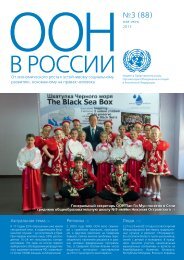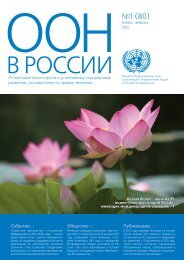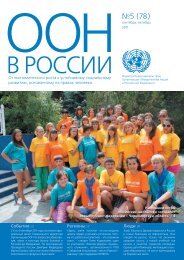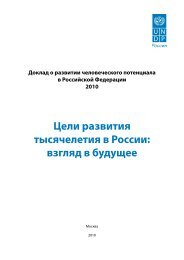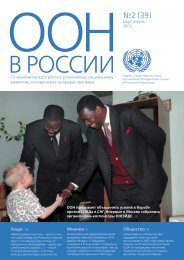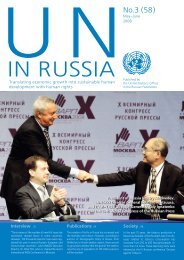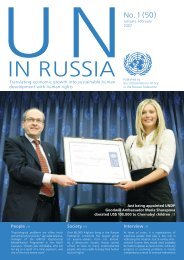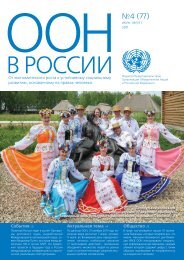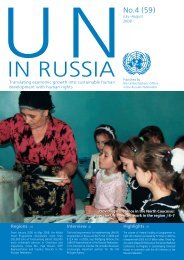Special issue 60th Anniversary of the Universal ... - UN Russia
Special issue 60th Anniversary of the Universal ... - UN Russia
Special issue 60th Anniversary of the Universal ... - UN Russia
- No tags were found...
Create successful ePaper yourself
Turn your PDF publications into a flip-book with our unique Google optimized e-Paper software.
adoption <strong>of</strong> <strong>the</strong> Forced Labour Convention,1930 (No. 29) followed <strong>the</strong> 1926 SlaveryConvention <strong>of</strong> <strong>the</strong> League <strong>of</strong> Nations, with<strong>the</strong> main purpose at that time <strong>of</strong> putting anend to <strong>the</strong> practice <strong>of</strong> compulsory labourused by colonial powers in <strong>the</strong>ir colonies.However, it remains fully valid for independentcountries. The Convention providesin particular a definition <strong>of</strong> forcedlabour, which needs to be suppressed as “allwork or service, which is exacted from anyperson under <strong>the</strong> menace <strong>of</strong> any penaltyand for which <strong>the</strong> said person has not<strong>of</strong>fered himself voluntarily”. It includes alimitative list <strong>of</strong> circumstances in whichwork can none<strong>the</strong>less be imposed, such ascompulsory military service, as a consequence<strong>of</strong> conviction in a court <strong>of</strong> law or incases <strong>of</strong> emergency.The Abolition <strong>of</strong> <strong>the</strong> Forced LabourConvention, 1957 (No. 105), does notrevise but supplement Convention No. 29.Following <strong>the</strong> experience <strong>of</strong> massiverecourse to forced labour during WorldWar II, it was adopted in 1957 to combatemerging new forms <strong>of</strong> forced or compulsorylabour that were witnessed at thattime. In particular, it fur<strong>the</strong>r protects <strong>the</strong>right to freedom <strong>of</strong> opinion and expressionconsecrated in <strong>the</strong> <strong>Universal</strong>Declaration by prohibiting <strong>the</strong> use <strong>of</strong> anyform <strong>of</strong> forced labour “as a means <strong>of</strong> politicalcoercion or education, or as apunishment for holding or expressingpolitical views, or views ideologicallyopposed to <strong>the</strong> established political,social or economic system.” It also prohibitsforced labour as a method <strong>of</strong> labourmobilisation for economic development.Equality <strong>of</strong> opportunity and treatmentat work is also supported by two conventions.The Equal RemunerationConvention, 1951 (No. 100), has <strong>the</strong>limited although important objective <strong>of</strong>achieving equal remuneration betweenmen and women for work <strong>of</strong> equal value.It is worth noting that <strong>the</strong> principle doesnot only apply to <strong>the</strong> salary or wage butalso to any additional payment in cash orkind arising from <strong>the</strong> worker’s employmentand also that it refers to work <strong>of</strong>equal value ra<strong>the</strong>r than equal work.The Discrimination (Employment andOccupation) Convention, 1958 (No.111) was adopted with <strong>the</strong> broader objective<strong>of</strong> elimination <strong>of</strong> all discriminationsin all aspects <strong>of</strong> employment and occupation.It defines discrimination as any distinction,exclusion or preference made oncertain grounds, which has <strong>the</strong> effect <strong>of</strong>nullifying or impairing equality <strong>of</strong> opportunity,or treatment. The Convention listsseven grounds <strong>of</strong> prohibited discrimination– race, colour, sex, religion, politicalopinion, national extraction, and socialorigin – but leaves <strong>the</strong> possibility to ratifyingStates <strong>of</strong> extending <strong>the</strong> protectionafforded by <strong>the</strong> Convention to o<strong>the</strong>rgrounds <strong>of</strong> discrimination.The Minimum Age Convention, 1973(No. 138), is a consolidation <strong>of</strong> previousinstruments adopted by <strong>the</strong> ILO since 1919to regulate minimum age <strong>of</strong> admission toemployment or work in various sectors,and it applies to all sectors <strong>of</strong> economicactivity, whe<strong>the</strong>r or not children areemployed for wages. It requires a minimumage to be specified and raised progressively,which cannot be less than <strong>the</strong> age <strong>of</strong> compulsoryschooling and normally 15 years <strong>of</strong>age. A higher minimum age <strong>of</strong> no less than18 years must be set for employment orwork likely to jeopardize <strong>the</strong> health, safety,or morals <strong>of</strong> young persons while lightwork <strong>of</strong> children <strong>of</strong> 13 to 15 years can beauthorized provided such work does notprejudice <strong>the</strong>ir schooling.The Worst Forms <strong>of</strong> Child LabourConvention, 1999 (No. 182), does notrevise or replace in any way ConventionNo. 138. It was adopted in recognition <strong>of</strong><strong>the</strong> fact that, if <strong>the</strong> ultimate objective <strong>of</strong><strong>the</strong> effective elimination <strong>of</strong> child labourdepends on economic factors and maytake time to be accomplished, <strong>the</strong>re arecertain forms <strong>of</strong> child labour that cannotbe tolerated and subject to progressiveelimination. Therefore, Convention No.182 calls for immediate action to secure<strong>the</strong> prohibition and elimination <strong>of</strong> <strong>the</strong>worst forms <strong>of</strong> child labour, irrespective<strong>of</strong> <strong>the</strong> level <strong>of</strong> development or economicsituation <strong>of</strong> <strong>the</strong> country. These worstforms against which all persons under <strong>the</strong>age <strong>of</strong> 18 must be protected comprise: allforms <strong>of</strong> slavery or similar practices, suchas sale and trafficking, debt bondage,serfdom and forced or compulsorylabour, including <strong>the</strong> use <strong>of</strong> children inarmed conflicts; <strong>the</strong> use <strong>of</strong> a child forprostitution or pornography; <strong>the</strong> use <strong>of</strong> achild for illicit activities such as drugtrafficking; and work likely to harm <strong>the</strong>health, safety or morals <strong>of</strong> children, asdetermined at <strong>the</strong> national level.<strong>Universal</strong> ratification <strong>of</strong> <strong>the</strong>se fundamentalconventions is now withinreach, as suggested by a current globalratification rate <strong>of</strong> about 90% amongILO Member States. For <strong>the</strong>se countries,this does not only mean a legal commitmentto ensure full respect for humanrights in <strong>the</strong> world <strong>of</strong> work, but alsoaccepting that <strong>the</strong>ir compliance be subjectto <strong>the</strong> scrutiny by tripartite bodieswith participation <strong>of</strong> governments,employers, and workers representatives.This will allow <strong>the</strong> ILO unique structureand procedures to continue assisting <strong>the</strong>international community in overcoming<strong>the</strong> ever renewed challenges to <strong>the</strong>effective observance <strong>of</strong> rights proclaimedsixty years ago.Alain PELCE,Senior InternationalLabour Standards <strong>Special</strong>istILO Subregional Officefor Eastern Europe and Central AsiaILO Moscow15 Petrovka St., <strong>of</strong>fice 23,tel.: +7 (495) 933-58-93Fax: +7 (495) 933-08-20Web site: www.ilo.org10ООН В РОССИИ №5 (60)



